Samsung Epic 4G Review: The Fastest Android Phone
by Anand Lal Shimpi on September 6, 2010 5:28 PM EST- Posted in
- Smartphones
- Samsung
- Epic 4G
- Gadgets
- Mobile
The Fastest GPU in a Smartphone
One thing I’ve learned over the past several years is that if you’re not the original manufacturer of something and are simply a glorified parts assembler, you generally have no clue how to do something right. There are obvious exceptions (Apple appears to be doing well), but this characterization applies to a lot of companies in the consumer electronics industry. They buy chips and parts from various suppliers, do a little bit of industrial design and generally don’t have the engineering know-how to deliver an optimized product into the marketplace.
Samsung is quite the opposite. Samsung is a DRAM manufacturer, a NAND flash manufacturer, and an application processor manufacturer. Samsung is responsible for the DRAM, NAND and silicon that goes into every iOS device sold by Apple. The company knows a thing or two about engineering.
The SoC inside the Epic 4G and other Galaxy S parts is called Hummingbird. It’s a 45nm SoC that implements a standard ARM Cortex A8 running at 1GHz and a PowerVR SGX 540 GPU. Despite Samsung’s experience in silicon manufacturing, it’s not much of an architecture/design company so we do see a lot of IP licensing within Hummingbird.
In this capacity Samsung is no different than TI, but what really sets Hummingbird apart is its GPU. Licensed from Imagination Technologies, the PowerVR SGX 540 is a significant improvement over the 530/535 in use in the iPhone, iPad and Motorola’s Droid X.
The SGX 530 has two USSE pipes and a single texturing unit. The 535 adds a second texturing unit, and the 540 adds another two USSE pipes. It’s unclear what clock speed the SGX 540 runs at inside Hummingbird, but I’d expect it’s somewhere near the 200MHz of the 535 in TI’s OMAP 3630.
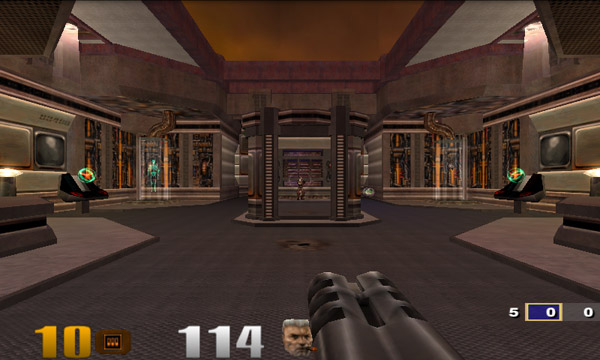
Quake 3 Arena running on the PowerVR SGX 540
The added execution hardware does incur a power penalty, however Imagination lists it as less than double the SGX 535.
The performance improvement is tangible. Samsung’s Hummingbird faster in 3D games/apps than any other SoC used in a smartphone today:
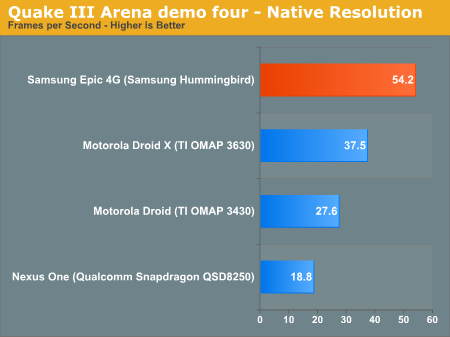
Under Quake III we saw a 44.5% increase in performance over the Droid X. Compared to Qualcomm's Snapdragon, performance improves by nearly 2x.
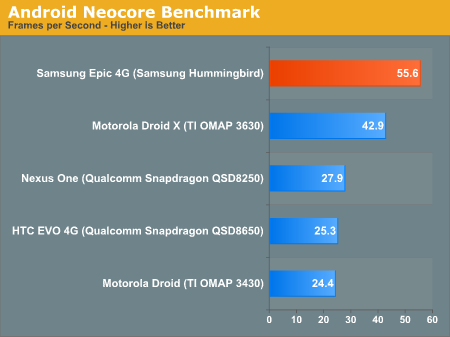
Even in Qualcomm's own 3D test, the PowerVR SGX 540 is more than twice as fast as the Snapdragon. We see a 30% performance advantage over the OMAP 3630. I'd expect to see about the same advantage over Apple's A4.
Unfortunately for Samsung, 3D gaming hasn’t really taken off on Android as a platform. The best examples of what’s to come are what we’ve seen from Epic and id, but both of those demos were done on iOS (although I suspect Android versions would hit at some point) and we’re still pretty far away from having actual games based on those engines on mobile phones.
While the SGX 540 could be responsible for the Epic 4G’s smoother than expected UI, it’s mostly a waste of hardware today. Clearly you don’t need this powerful of a GPU to make scrolling through menus smooth. Perhaps Samsung has grand plans for Hummingbird or simply wanted to outdo the competition on paper. Higher resolution products due out in the future will demand faster GPUs (think tablets) so it’s possible that Hummingbird wasn’t specifically targeted for an 800 x 480 smartphone.
General CPU performance is comparable to the OMAP 3630 and what you’d expect from a 1GHz Cortex A8. The 45nm SoC should sip power but it’s unclear what Samsung is doing for power management on the SoC itself. While both Hummingbird and Apple’s A4 are manufactured at the same fab at 45nm and both use the Cortex A8, there’s a lot more to determine the total power consumption of an SoC.

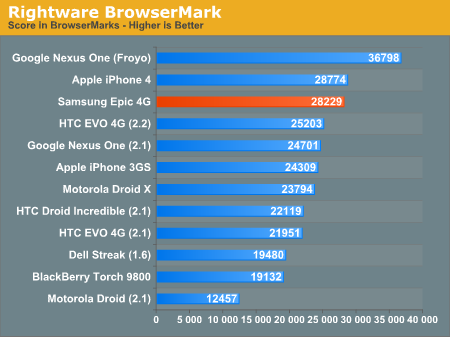
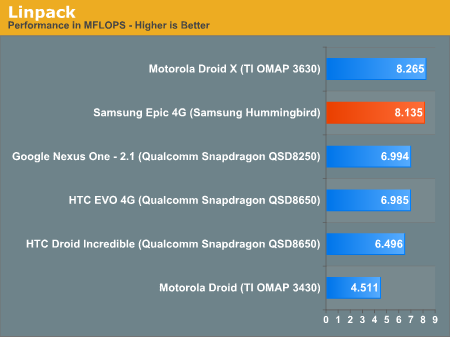
Hummingbird’s memory bus is likely a 32-bit single channel LPDDR1 interface, but overall I’d say it’s safe to say that this is the fastest SoC currently shipping in a smartphone. Apple’s A4 used in the iPhone doesn’t run at 1GHz, and TI’s OMAP3630 uses the PowerVR SGX 530 compared to Samsung’s SGX 540. Unfortunately much of the performance advantage will go unused as 3D gaming simply isn’t that prevalent on Android phones today.










93 Comments
View All Comments
dvinnen - Tuesday, September 7, 2010 - link
I bet it has to do with the 4G/WiFi-MAX radio. I have a Vibrant and the battery life is fineMilind - Tuesday, September 7, 2010 - link
I think that's possible since my Vibrant gives me about 6-7 hours of battery life with full brightness and the screen consumes about 70-80% of my battery as per the battery usage view. I don't care since I'm typically around a charger so I set it at max brightness. But if I were to lower the brightness, I should easily be able to go for the whole day. Even at 0 brightness, the screen is surprisingly usable.I have also noticed that the only thing that drains battery faster than the screen (in my G1 as well), is if it has to hunt for a phone signal. At one time, my G1 was draining battery in about 2-3 hours, which was awful even by the G1's sorry battery life standard. It turned out to be because I was using a SIM card of a provider that had very poor coverage at the location. As soon as I swapped the SIM with another carrier, the battery life went back up. So it's possible that Sprint's causing the phones to go back and forth between 2g, 3G and 4G signals causing the battery to drain faster. It might be worthwhile to go into the Mobile Networks settings and use only 2G network to check the battery drain. Obviously this would just be to test the hypothesis. It would be stupid to buy this phone and use it only in 2G mode.
jamawass - Tuesday, September 7, 2010 - link
The GPS on my Pre Plus is perfect.Voldenuit - Tuesday, September 7, 2010 - link
Thanks for reviewing the Galaxy S, Anand!Probably the most requested review here. I'm actually glad that the battery life turned out to be abysmal - it helped me make up my mind about an otherwise desirable phone.
Let me explain: My fiancée had two dead Samsung Blackjacks within one warranty period. My Samsung Spinpoint F1 is dying. My mother just junked a dead Samsung TV (5 yrs old). To be perfectly frank, I have ZERO confidence in Samsung products, and the build quality of the Galaxy gives me no reason to revise that opinion.
Fortunately, the poor battery life gives me a legitimate excuse not to buy this, and I won't feel like I am missing out on anything because of a possibly irrational aversion. Sure, it's nice to have a fast phone, but by the time apps come out that make meaningful use of this, there will be *much* faster phones on the market. Buying for future-proofing is not a smart idea in the smartphone space.
Voldenuit - Tuesday, September 7, 2010 - link
PS Still looking for that 'perfect' (Android) smartphone. Evo 4G is too big and power hungry, Droid X plans are too expensive.Something like the recently announced Droid Defy might work, if only it didn't have eFuse, Motoblur, and wasn't tied to a sucky carrier.
I'm perfectly willing to wait 1 year on a post-paid phone plan for a decent phone to come out. Even the Torch would work for me, though probably not for the missus.
First and foremost for me is that it should be a phone above all things and 'smart' second. If you're going to chew the battery life tweeting and watching youtube on it, then have no juice to call AAA when you break down on the highway, it's useless to me. Integration with social apps is also something of a nightmare for me - there are people I may enjoy hanging out with on social occasions, but that doesn't mean I wish to know what they are eating, thinking, drinking or (bodily function deleted) during office hours. Somebody, please get this. So far, only Blackberry seems to. Fortunately, most other BB users are sober/boring enough that BBM is a good way to communicate for the dour, buttoned-down crowd. :p
Mike1111 - Tuesday, September 7, 2010 - link
I think it's worth mentioning that SuperAMOLED is officially a Samsung smartphone exclusive until 2012 (IMHO mostly because of limited AMOLED manufacturing capacity until the new Samsung OLED fab is up and running in 2012) . So you won't see it anywhere else in the near future. So please people, don't bitch about missing Super AMOLEDs in every smartphone that's coming in the next 18 months...Mike1111 - Tuesday, September 7, 2010 - link
Anand, your mixing your SGX versions when mentioning the OMAP3630. One time it's SGX535, the next SGX530. I think SGX530 is correct.Milind - Tuesday, September 7, 2010 - link
>>Thankfully Samsung provides a setting to sync these two so both the screen and buttons go blank at the same time, but it’s just not enabled by default.
>>
I have seen this posted a couple of times, but I can't find any such setting on my Vibrant. Is it on the Epic? Can someone provide a little detail on exactly where this setting is? The timeout for lighting the buttons is just too short and very annoying.
Anand Lal Shimpi - Tuesday, September 7, 2010 - link
On the Epic it's here:Settings -> Sound & Display -> Keyboard timeout (last option in the list) -> Same as screen timeout
Take care,
Anand
Milind - Tuesday, September 7, 2010 - link
Thanks Anand. That option is not present on the Vibrant. The last option on the Vibrant for Sound and Display is TV out. Hopefully, it will be part of the Froyo update.